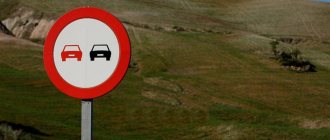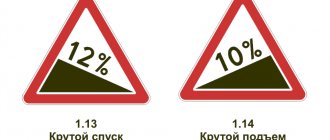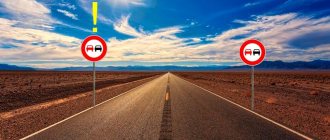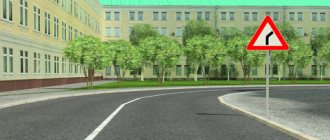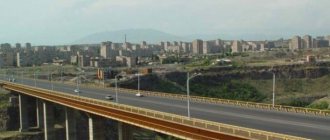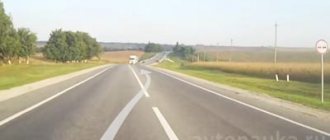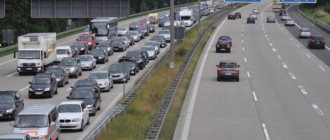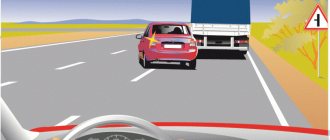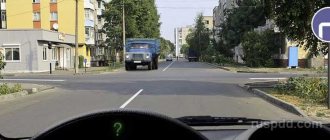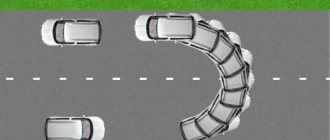Is overtaking allowed in the presence of artificial lighting?
The increased danger of structures such as tunnels is obvious, but what if the underground structure is equipped with artificial lighting? Is it possible that in this case the driver has the right to overtake vehicles in the oncoming lane if he is convinced that it is safe to do so?
Turning to clause 11.4 of the Russian Traffic Regulations, it becomes obvious that the conditions allowing the driver to overtake in this case have not been established. That is, neither the presence of artificial lighting, nor traffic congestion, nor other factors allow drivers to violate this rule regarding overtaking and other maneuvers.
To overtake or not to overtake
Overtaking is the action of overtaking the vehicle in front. But it is different from “advanced”. Its main difference is that the car moves into the adjacent lane, and then, having overtaken the car, returns to the same lane.
A tunnel is a long underground structure that serves to facilitate the movement of vehicles. The tunnel is an artificial structure, and just like all other underground (and above-ground) structures, it is an object of increased danger. Therefore, according to clause 11.4 of the traffic rules, overtaking vehicles in tunnels is prohibited, and overtaking on overpasses (and under them), at railway crossings, on bridges, pedestrian crossings and the main road at an uncontrolled intersection or at a controlled intersection is also unacceptable, because such actions are unsafe for other drivers or pedestrians. But the exception is a vehicle that moves on the main road.
Is overtaking allowed when there are intermittent markings?
In order to answer this question, the traffic rules should be addressed again. In order not to provoke an accident, motorists should know that not every broken line allows overtaking. For example, markings 1.5 and 1.6 allow you to maneuver through them to change lanes or overtake, but if there are blocking signs, such actions are prohibited.
However, last summer, intermittent markings began to appear in Moscow tunnels instead of continuous lines, where minimum accident rates were determined. Thus, motorists were able to make previously prohibited lane changes. This change is already in effect in more than 20 tunnels in the capital.
Overtaking a slow-moving vehicle
Hello, dear readers! Today we will return to the topic of overtaking and the conversation will focus on the possibility of overtaking slow-moving vehicles, horse-drawn carts, bicycles, mopeds and two-wheeled motorcycles without a side trailer, in the presence of prohibitory sign 3.20 “Overtaking is prohibited”.
3.20 "Overtaking is prohibited." It is prohibited to overtake all vehicles except slow-moving vehicles, horse-drawn vehicles, bicycles, mopeds and two-wheeled motorcycles without a side trailer.
As we can see from the description of the prohibitory sign 3.20 “Overtaking is prohibited”, it does not prohibit us from overtaking slow-moving vehicles, horse-drawn carts, bicycles, mopeds and two-wheeled motorcycles without a side trailer.
Before we continue, let's look at what the Regulations say about slow moving vehicles. There is no definition, there is only the name of the sign “Slow-moving vehicle”, the description of which mentions that low-speed vehicles must be marked with a sign and the maximum speed for which is set by the manufacturer to no more than 30 km/h.
“Slow-moving vehicle” - in the form of an equilateral triangle with a red fluorescent coating and a yellow or red reflective border (triangle side length from 350 to 365 mm, border width from 45 to 48 mm) - behind motor vehicles for which the enterprise - the manufacturer has set the maximum speed to no more than 30 km/h.
This is a very important note, telling us that we cannot accept any vehicle moving at a speed of less than 30 km/h as a low-speed one. In the photo below we see a tractor, but its speed can be higher than 30 km/h.
And if we overtake in the area covered by prohibitory sign 3.20 “Overtaking is prohibited,” then we will have to answer under Part 4 of Article 12.15 of the Code of Administrative Offenses of the Russian Federation.
4. Driving, in violation of the Traffic Rules, onto a lane intended for oncoming traffic, or onto tram tracks in the opposite direction, except for the cases provided for in Part 3 of this article,
shall entail the imposition of an administrative fine in the amount of five thousand rubles or deprivation of the right to drive vehicles for a period of four to six months.
Therefore, if everything is clear with horse-drawn carts, bicycles, mopeds and two-wheeled motorcycles without a side trailer and it is allowed to overtake them, then with other vehicles we need to be careful, since we certainly cannot know the maximum speed set for them by the manufacturer. If in front of us, for example, is an asphalt paver (a complex linear road-building machine), then we can try to overtake it (maximum transport speed is 15-18 km/h), but we must keep in mind that if there is no “Slow-moving vehicle” sign on it, you may the truth will have to be proven in court. But it’s not worth overtaking a tractor, even if it’s moving slowly. With modern tractors, the maximum speed can be quite high. For example, the speed of the JCB Fastrac tractor can reach 70 km/h.
There is only one piece of advice here: if a vehicle does not have a “Slow Moving Vehicle” sign, then it is not worth overtaking it in the coverage area of sign 3.20 “Overtaking Prohibited”, otherwise such a maneuver can be quite expensive, at best, a fine of five thousand rubles, in another, deprivation of the right to drive vehicles for a period of four to six months.
Now let’s consider a situation that very often occurs on the roads, when together with sign 3.20 “Overtaking is prohibited” there is a continuous marking 1.1 or 1.11 on the road, and in front of us is a slow-moving vehicle.
As follows from the Rules, it is prohibited to cross these markings (1.11 it is allowed to cross from the intermittent side).
1.1 — separates traffic flows in opposite directions and marks the boundaries of traffic lanes in dangerous places on the roads; indicates the boundaries of the roadway to which entry is prohibited; marks the boundaries of vehicle parking spaces.
1.11 — separates traffic flows of opposite or similar directions on sections of roads where changing lanes is allowed only from one lane; denotes places intended for turning around, entering and exiting parking areas, and the like, where traffic is allowed only in one direction.
Lines 1.1, 1.2.1 and 1.3 are prohibited from crossing.
Line 1.11 is allowed to be crossed from the broken side, as well as from the solid side, but only upon completion of overtaking or detour.
What we see is that the prohibitory sign 3.20 “Overtaking is prohibited” allows overtaking, but the markings do not, since crossing it is prohibited. The prohibition to cross marking lines 1.1, 1.3 or marking 1.11 (the broken line of which is located on the left) is expressly stated in paragraph 9.11 of the Rules.
9.11. On any two-way roads, driving in the lane intended for oncoming traffic is prohibited if it is separated by tram tracks, a dividing strip, markings 1.1, 1.3 or markings 1.11, the broken line of which is located on the left.
If you decide to overtake a slow-moving vehicle in the area covered by sign 3.20 “Overtaking is prohibited,” do not forget that although the sign does not prohibit overtaking, the Rules of the Road contain clauses 9.11 and 11.4 that limit the execution of this maneuver.
11.4. Overtaking is prohibited: at signalized intersections, as well as at uncontrolled intersections when driving on a road that is not the main one; at pedestrian crossings; at railway crossings and closer than 100 meters in front of them; on bridges, overpasses, overpasses and under them, as well as in tunnels; at the end of a climb, on dangerous turns and in other areas with limited visibility.
Drivers of slow-moving vehicles and others moving at low speeds, do not forget about paragraph 11.6 of the Rules.
11.6. If, outside populated areas, overtaking or ahead of a slow-moving vehicle, a vehicle transporting large cargo, or a vehicle moving at a speed not exceeding 30 km/h is difficult, the driver of such a vehicle must take as far to the right as possible, and if necessary stop to allow following vehicles to pass.
Good luck to everyone on the road!
What are the dangers of overtaking in a tunnel?
A Subaru drives into a traffic jam in a tunnel.
The consequences of a dangerous maneuver, such as overtaking in a tunnel, are fraught not only with an accident in which the vehicle will be damaged, but also threatens the health and lives of the drivers themselves and their passengers.
Most often, as a result of an accident in a tunnel, dangerous consequences arise such as:
Dear reader! Didn't receive an answer to your question? Our expert lawyers work for you. It's absolutely free!
- Moscow ext 152
- St. Petersburg ext 152
- All regions ext 132 (Toll free)
- the inability of other road users to orient themselves in time to mitigate the situation due to limited visibility and unnatural lighting;
- an increase in the number of accident participants who were unable to avoid a collision in a confined space with distorted lighting;
- the lack of fresh air due to the accumulation of exhaust gases inside the underground structure has a significant negative impact on victims of the accident.
Do not forget that in a confined space, the movement of other vehicles is difficult, and they are actually unable to pass each other.
To prevent such sad consequences, every driver should be aware of the rules for driving in tunnels:
- First of all, it is important to remember the restrictions that apply to any maneuvers in underground structures;
- Pay attention to signs that set speed limits. They are always located at the entrance to an underground structure;
- Remember the recommendations regarding the safe distance between vehicles in traffic. The minimum distance between adjacent cars must be at least 20 meters;
- Consider the average speed of the moving stream;
- To ensure that changing the light mode does not have a negative impact, before entering the tunnel, first turn on the low beam headlights. If you are wearing sunglasses, take them off so that light distortion does not lead to strong contrast, and therefore disorientation. Before leaving, put them back on to eliminate the possibility of being blinded by sunlight;
- If you have air conditioning, turn it on, or use the forced ventilation function, since polluted air inside the tunnel may well have a negative impact on the general condition of the driver and passengers. It is also recommended to close the windows accordingly;
- If there are traffic jams or other congestions in the tunnel that do not allow drivers to travel this distance without hindrance, the emergency lights should be turned on. During long periods of inactivity (more than 1 minute), in order to save oxygen, turn off the engine. In more dangerous cases, motorists trapped in an underground structure should wait for emergency services to arrive and instruct them on further action.
When is overtaking prohibited by the rules?
In accordance with the Traffic Regulations 2013, before overtaking, you should make sure that when performing this maneuver, no interference will be created for other road users, and make sure that there is no sign prohibiting the maneuver (3.20). The person behind the wheel must analyze the traffic situation, choose a safe distance to overtake, and only then “go around” passing vehicles. Moreover, it is very important to make sure that there are no cars in the oncoming lane.
Overtaking is prohibited in the following cases:
- a car moving in front in the same lane as the car that plans to overtake signals that its driver wants to turn left;
- the car in front is detouring or overtaking an obstacle;
- the car following your car has started overtaking.
Overtaking is also prohibited when the driver realizes that after completing the planned maneuver he will not be able to safely return to his lane. From the point of view of basic common sense, all these prohibitions look completely justified. Each motorist understands perfectly well that this is exactly how they need to behave on the road, taking care of the safety of traffic on it.
Now let's remember those places on the highways where overtaking is generally prohibited. In the 2013 Traffic Regulations, these include the following sections of the road:
- overpasses, overpasses, bridges and spaces under these engineering structures;
- pedestrian crossings;
- signalized intersections;
- dangerous turns and final sections of climbs;
- intersections without traffic lights or traffic controllers (overtaking is prohibited in cases where the car is not traveling on the main road);
- areas with limited visibility;
- tunnels;
- crossings across the railway track (the maneuver described in the article is also prohibited less than a hundred meters before such crossings).
The rules, approved in 2013, indicate that the driver behind the wheel of an overtaken car is prohibited from increasing speed while another vehicle is “passing” it, or in any other way preventing the overtaking vehicle from starting and completing a planned maneuver.
Moreover, in situations where a slow-moving vehicle (for example, a truck) is moving along the road, traffic regulations require that it assist the vehicle behind in overtaking (either completely stop or move to the right). This rule applies when driving outside populated areas. By the way, this is also true for cases of ahead of vehicles, and not just overtaking them.
What is the fine for overtaking in a tunnel?
Responsibility for violating the rules regarding overtaking in a tunnel is defined in the Code of Administrative Offenses of the Russian Federation and directly in Article 12.15. Based on the provisions of this norm, a fine of 5 thousand rubles may be applied to the violator, or the motorist may lose his driver’s license for a period of 4 to six months.
If the driver commits a violation again, and this fact is recorded by video surveillance cameras, which operate automatically, then instead of deprivation of his license, he may face a fine of 5 thousand rubles. The commission of gross offenses by drivers related to the operation of cars in tunnels is strictly punishable by the norms of the Code of Administrative Offenses of the Russian Federation.
What is the punishment for violating the rules?
Fines for violating traffic rules in the tunnel include:
| Did not find an answer to your question? Call a lawyer! Moscow: +7 (499) 110-89-42 St. Petersburg: +7 (812) 385-56-34 Russia: +7 (499) 755-96-84 |
- Overtaking - 5,000 rubles or deprivation of a driver's license for a period of 4 to 6 months. In case of repeated violation, the driver will be deprived of his license for a year.
- Stopping and parking - 2000 rubles.
- For overtaking, turning or driving in reverse - 500 rubles.
- For exceeding the established speed limit - from 500 rubles to 5000 rubles or imprisonment for 4-6 months, depending on how much the speed was exceeded. The most severe fine will be if the speed is exceeded by 80 km/h or more.
Tunnels are built only on those road sections where there is a need for it. Because this structure increases the risk of accidents, traffic rules there are stricter than on open road sections. Compliance with traffic rules will help keep your finances, driver’s license, car intact, and most importantly, life, personal health and the health of passengers.
Travel rules
To avoid getting into an emergency in the tunnel, the driver is advised to strictly follow the following rules:
- When entering a tunnel, remember the existing restrictions on overtaking, turning, advancing and other maneuvering rules.
- Always adhere to the speed limit posted by the signs posted at the entrance to the tunnel.4
- Keep your distance. The current version of the rules does not establish a certain distance between cars in the tunnel. However, according to UN recommendations, this distance should be at least 20 m - 50 m.
Since several cars can be within sight at the same time, it is recommended to take into account the interval between neighboring cars, as well as the average speed of the flow. Keeping your distance will help you avoid collisions with vehicles that have previously been involved in an accident.
- Avoid the negative effects of sudden changes in light conditions. Before entering the tunnel, it is recommended to turn on low beam headlights and take off your sunglasses, and before leaving, put your glasses back on. This will eliminate the possibility of blinding the driver and reduce the risk of an accident.
- Retune your radio before entering the tunnel. In long tunnels there is a local radio that constantly informs drivers about the current traffic situation in one direction or another.
- Check the amount of fuel in the tank. For the Russian Federation, this rule is not of particular importance, since there are very few tunnels with a long length, but in other countries, for example, in Norway, some tunnels have a length of more than 50 km.
- Before entering, turn on forced ventilation in the car, as stale air can negatively affect the driver’s health.
- If there is a jam in the tunnel, you must:
- immediately turn on the hazard warning lights to warn drivers behind you;
- maintain the recommended distance between vehicles;
- When stopping, turn off the engine to conserve air;
- switch to the radio wave and strictly follow the recommendations of emergency services.
- If you hit in the tunnel, then:
- turn off the engine;
- put on an emergency vest (the latest amendments establish the need to have a vest when operating a car);
- display an emergency stop sign;
- provide first aid to victims;
- report an accident to emergency services;
- leave the tunnel through the nearest emergency exit before emergency services arrive.
- If there is a fire in the tunnel, it is recommended:
- if possible, leave the tunnel;
- if this is not possible, then turn off the car and call rescue services;
- If possible, provide assistance to the victims;
- leave the tunnel through emergency exits.
While driving on the roads, drivers are forced to use a variety of maneuvers to get to their destination faster. But at the same time, you must follow the established rules so as not to create emergency situations and not become lawbreakers. Overtaking is one of these maneuvers, which, when performed according to traffic regulations, will be quite harmless. But every driver should know what overtaking is and what standards should be followed in order to avoid paying fines later.
